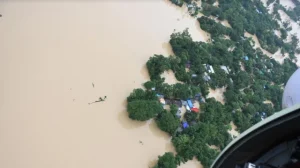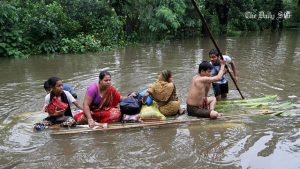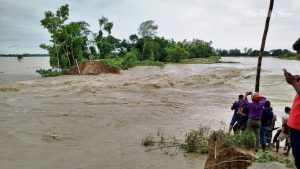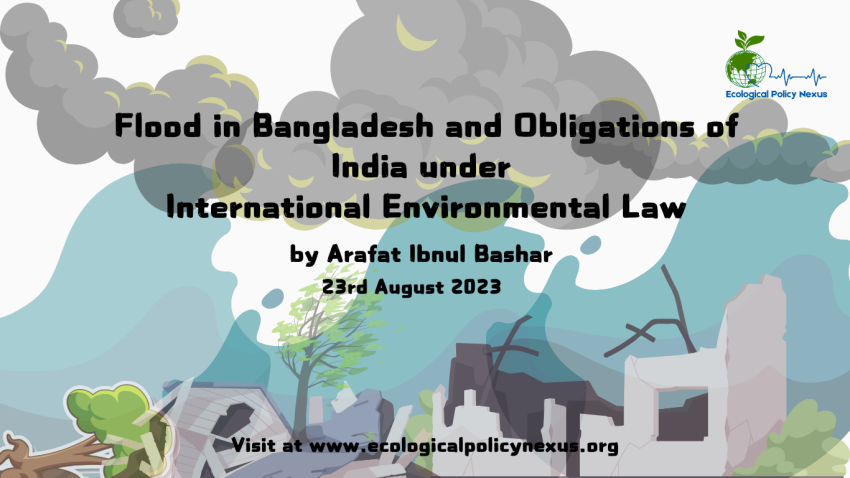Written by Arafat Ibnul Bashar
Eight districts of Bangladesh are witnessing the worst flood scenario in recorded history. Three million have been reported to be stranded in these districts and more and more areas are rapidly going under water. Some areas which have never been affected by flood, as per the collective memory of the residents are now under water. A continuous rainfall caused by a persistent monsoon low-pressure system coupled with a strong Madden-Julian Oscillation and the jet stream’s current position over Central Asia is responsible for the disastrous flood condition.
On top of these natural causes, it is assumed that India’s opening of the Dumbur dam in Tripura is a contributing factor to the floods. The Indian Ministry of External Affairs on Thursday, however, claimed that the concerns that the opening of the Dumbur dam is responsible for the flood condition in Bangladesh are factually not correct. According to India, the catchment areas of the Gumti River that flows through both countries have witnessed the heaviest rains of the year over the last few days, which is responsible for the floods in Bangladesh.
Further, India has also stated that they faced some problems in communicating with Bangladesh, due to power outage caused by the floods. However, although India has informed Bangladesh about heavy rainfall and flood, there was no specific information regarding the opening of the dam. Again, besides the Dumbur dam in Tripura, the Kalashi dam of Tripura has contributed to the flood in Feni, which is one of the most seriously affected places.

(Figure 1: ISPR Dhaka Tribune)
While the truth of this statement is yet to be ascertained, there is outrage among Bangladeshis regarding the situation. Information Advisor Md Nahid Islam has already stated that India opening the dam without prior warning or opportunity for preparation shows the country’s inhumanity and non-cooperation with Bangladesh.
Some netizens have even referred to the situation as “water terrorism” by India, a term that is not only unique to the legal sphere but also in a layman’s dictionary. This is because rivers and water have been a serious bone of contention between Bangladesh and India for a long time. In 1976, Bangladesh even had to raise the issue against India’s unilateral withdrawal of water at Farakka in the General Assembly of the United Nations. Prior to the Farakka Project, India denounced the Barcelona Convention and Statute on the Regime of Navigable Waterways of International Concern, 1921, which could have been invoked by (East) Pakistan in establishing its argument against the project. The reduced flow of the Ganges has severely impacted 33% of the population in Bangladesh, who are dependent on Ganges basin.


(Figure 2: Feni; The Daily Star, Figure 3: Habiganj; The Daily Star)
As we ponder, the developing situation of the floods, it must be kept in mind that under the customary rules of the International Environmental Law, India is under the obligation to refrain from any steps that might have any disastrous environmental consequences in Bangladesh. Foremost, any step that India takes must conform to the principle of Prevention of Harm which dictates that no state has the right to use its territory in such a manner that may cause injury to another territory. Also known as the principle of transboundary harm, this principle has been enshrined in the Stockholm Declaration, 1972 and the Rio Declaration, 1992. The objection of this rule is to minimize the risk of environmental harm and also to determine the authorization of any administrative decision that may have an environmental impact. This rule is said to be breached when a state’s behavior is contrary to a specific standard of care, and it fails to take proportionate measures to minimize a foreseeable risk. Even if the opening of the dam could be justified to prevent the dangers of flood in Tripura, the rule of transboundary harm is also further coupled with the rule of prior notification.
The rule of prior notification stipulates that if the activity of a state has the potential to damage the environment outside its border, it must give the affected state(s) a prior notification of its plan, and possibly engage in discussions of the plan in good faith. This rule is an important aspect of water diplomacy and contributes to the cooperative management of shared water resources. The rule can be found in some basin-specific treaties such as the 1964 Convention and Statutes relating to the Development of the Lake Chad Basin, the 1975 Statute of the River Uruguay, the 2002 Framework Agreement for the Sava River Basin, the 2003 Protocol on the Sustainable Development of the Lake Victoria Basin etc. and also in global instruments like Convention on the Law of the Non-navigational Uses of International Watercourses, 1997, United Nations Convention on the Law of the Sea, 1982 etc. Whether the steps that were taken by a state in an emergency permitted sufficient time to accommodate a prior notification followed by consultation is a question of fact.
Besides, states are also under the obligation to cooperate with each other on any matter that impacts the global environment as well as environmental matters regarding its neighboring countries. Principle 24 of the Stockholm Declaration states that:
“International matters concerning the protection and improvement of the environment should be handled in a cooperative spirit by all countries, big and small, on an equal footing.”
If India is found to have violated the principles of Prevention of Harm and Prior Notification (and consultation), it can be held liable for committing internationally wrongful acts. Again, both of these rules have been enshrined in the Convention on the Law of the Non-navigational Uses of International Watercourses, 1997, an international treaty that deals with the uses and conservation of waters that cross international boundaries. Both Bangladesh and India have refrained from ratifying this treaty, which makes disputes relating to international watercourses and sharing of water dependent on bilateral talks and agreements. And thus far, the bilateral method of resolving such disputes has not been particularly beneficial for Bangladesh.
Bangladesh must inquire into the truth of the statement made by India and take necessary diplomatic steps. Syeda Rizwana Hasan, the Adviser for Environment, Forest and Climate Change has informed that the ministry would take necessary steps to initiate a cooperative bilateral or multilateral solutions for the international river related issues, according to the report of The Business Standard. Professor Muhammad Yunus, the Chief Adviser had a meeting with Indian High Commissioner in Dhaka in order to find scopes to get early warning in flashfloods. One of the expected measures was discussed in the meeting – flag meeting or flag showing communication among Bangladesh Border Guard (BGB) and Border Security Force (BSF) in the time of emergency.
A cooperative bilateral resolution of the matter is highly desirable by both countries, and in order to achieve it, both Bangladesh and India must satisfy their respective obligations under International Environmental Law. Bangladesh should also bring the matter to the Indo-Bangladesh Joint Rivers Commission, the bilateral working group of the two countries. The statute of the commission provides for flood control among its scope.
References:
- Faruque A.A., (2017) Environmental Law: Global and Bangladesh Context. (New Warsi Book Corporation, Dhaka.) p. 49-54, 72.
- Islam M.N., (2023) ‘Sharing’ Ganges Water: Indo-Bangladesh Treaties and International Law. (University Press Limited, Dhaka) p. 71-72.
- Rio Declaration on Environment and Development, U.N.Doc.A/CONF.151/5/Rev.1 (16 June, 1992).
- UN General Assembly, United Nations Conference on the Human Environment (The Stockholm Declaration), A/RES/2994, 15 December 1972.
- Nanda V.P. and Pring G., (2003) International Environmental Law and Policy for the 21st Century. (Transnational Publishers, New York) p. 55.

